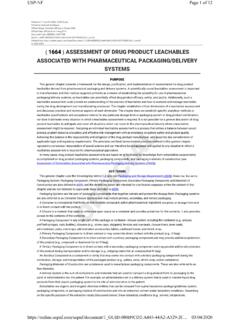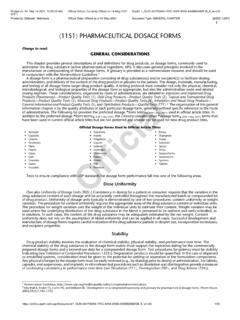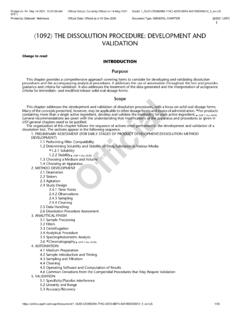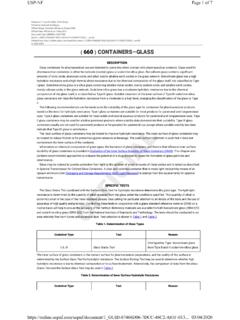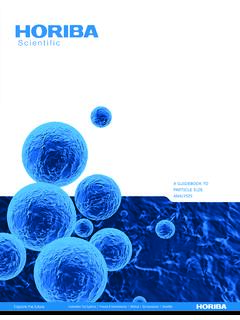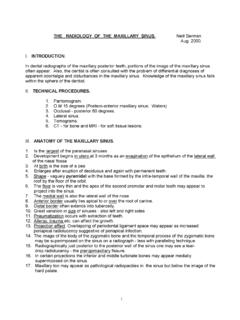Transcription of Module 08 USP 1115 Bioburden Control of Non-Sterile …
1 USP <1115> Bioburden Control of Non-Sterile Drug Substances and Products2 2019 USP No well defined regulatory standards or guidance exists for the microbiological / Bioburden Control of Non-Sterile pharmaceutical manufacturing environments Environmental Control and monitoring of Non-Sterile processes either range from non-existent to parallel programs to aseptic processing Data generated from some programs may be of little value for the Control of the microbiological quality of Non-Sterile environments in which the product is manufacturedUSP <1115> Bioburden Control of Non-Sterile Drug Substances and Products3 2019 USP Microbial contamination in Non-Sterile products is controlled to a level consistent with patient safety, but excessive controls that would add complexity/cost without a commensurate safety benefit are not advantageous to either the end user or the manufacturer.
2 Therefore, a scientifically pragmatic approach to management of the microbial Bioburden in Non-Sterile products requires consideration of patient risk and the contamination Control objectives required to achieve a practical level of risk management. ApproachSo, how do we effectively apply microbial Control in the manufacture of Non-Sterile products?4 2019 USP Use HACCP to understand the process Hazard Analysis & Critical Control Points (HACCP) is a safety management system that relies on process controls to minimize risks Define where microbial contamination could occur Effectively determine the best Control and monitoring methodsApproach5 2019 USP A hierarchy of Non-Sterile drug dosage forms with potential risk (high to low) to end users from a microbial contamination perspective is.
3 Metered-dose and dry powder inhalants Nasal sprays Otics Vaginal suppositories Topicals Oral liquids (aqueous) Oral liquids (non-aqueous) Rectal suppositories Liquid-filled capsules Compressed tablets and powder-filled capsulesHierarchy of Product Risk6 2019 USPNon- sterile Product Microbial Influences7 2019 USP While there are many factors that can result in the introduction of microorganisms, recent data on product failures and recalls indicate that the following factors are the most likely to result in product recalls due to higher than acceptable levels of microbiological content. These manufacturing risk factors are, in descending order: (1) ingredient water, (2) pharmaceutical ingredients, (3) process equipment, and (4) manufacturing personnel and (5) manufacturing <1115> Bioburden Control of Non-Sterile Drug Substances and Products8 2019 USP Appropriate written procedures, designed to prevent objectionable microorganisms in drug products not required to be sterile , shall be established and followed (21 CFR Control of microbiological contamination).
4 Regulatory Guidance9 2019 USPP oints to be considered by pharmaceutical microbiologists and product development teams when assessing the potential risk associated are: Synthesis, isolation, and final purification of the drug substance Microbial attributes of the drug substance Microbial attributes of the pharmaceutical excipients Formulation and microbial, chemical and physical attributes of the drug productProduct Development10 2019 USPP oints to consider: Water activity of the drug product Manufacturing process for the drug product Delivery system for the drug product Packaging of the drug product Storage conditions for the finished dosage form Route of administration of the drug product Expected treatment procedure and dosage regime Age and medical status of the intended recipients of the drug productProduct Development11 2019 USP process water is the single most important risk element contributing to the contamination of nonsterile products.
5 The quality or type of water used for nonsterile product formulation and final rinse of clean equipment should be chosen based on product risk. Purified waters used in pharmaceutical manufacturing are deionized and thus do not contain chlorine to Control microbial growth. Water12 2019 USP Substantial populations of Gram negative rod-shaped bacteria and many molds are able to grow in such purified dechlorinated water. Therefore, purified water should not be allowed to stand in pools or puddles for extended periods of time. Standing purified water should be drained or physically removed quickly and efficiently from both production vessels and equipment, as well as work surfaces and floors.
6 Water13 2019 USP process waters used for manufacturing of, excipients, and, in some cases, active ingredients for nonsterile products present a substantial risk for microbial colonization and proliferation, particularly for ingredients of natural origin that have received minimal processing to reduce Bioburden or to Control microbial proliferation. Water14 2019 USP Ingredients and excipients utilized in process formulation can be a significant source of microbial contaminants and are in fact the second leading cause of product recalls for microbial contamination. Vendor audits, specifications, testing, package selection, shipping, storage conditions and expiry dates are all critical in the reduction of microbial risk associated with these materials.
7 Pharmaceutical Ingredients15 2019 USP When manufacturers cannot conduct extensive vendor audits, they should select vendors with the demonstrated capacity to produce drug substances or excipients of suitable quality. Of particular concern are unprocessed materials of natural origin and those that have a high level of water activity. Pharmaceutical Ingredients16 2019 USP Supplier audits should be conducted to establish that the supplier has a well-designed and validated microbiological Control program for its manufacturing and packaging facilities. Depending on the microbial characteristics of an ingredient, manufacturers should consider periodic monitoring of the supplier s facility to assess microbiological contamination.
8 Pharmaceutical Ingredients17 2019 USP Materials that have low water activity, possess high or low pH, are not of natural origin, are inherently antimicrobial, or contain an antimicrobial preservative have a low risk for microbial colonization or proliferation. Risk assessments should consider ingredient characteristics regarding microbial survival, support of microbial growth, or frank antagonism to microbial Ingredients18 2019 USP The introduction of moisture into stored materials notably increases the risk of microbial contamination. Condensation in storage tank headspace or impermeable storage containers can result in contamination of materials with water-borne organisms even when the product under storage is expected to preclude microbial colonization or Ingredients19 2019 USP Manufacturers also should consider the suitability of methods for detecting relevant noncompendial organisms.
9 Primary packaging and intermediate containers ( , drum liners, plastic bags, and so on) can be a source of microbial contamination, and manufacturers should consider their initial quality, storage conditions, preparation, and handling Ingredients20 2019 USP Formulating and manufacturing equipment can be a source of contamination, and risks are higher when water and ingredients that are susceptible to microbial survival or growth are Design and Use21 2019 USP Cleaning, drying, and, where appropriate, sanitization of manufacturing equipment can be beneficial, but disinfectant residues should be limited in the operating environment and should be removed from product-contact surfaces.
10 The isolation of water-borne organisms, particularly Gram negative rods,is a likely indicator of failure to remove standing water on equipment and environmental surfacesEquipment Design and Use22 2019 USP Equipment specifications for the selection of equipment to be used in the manufacture of Non-Sterile products should include sanitary design; clean ability of equipment to allow removal of contaminants. Equipment should use sanitary fittings and be designed for easy use of cleaning and sanitizing agents and complete rinse water drainage. Equipment Design and Use23 2019 USP Residual water in tanks, piping, or on equipment surfaces introduces the risk of colonization by water-borne organisms.

